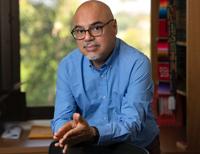
Cal State LA has a new campus in Chino, about 30 miles east of the main campus.
The single one-story structure is contained within a yard featuring a small lawn that provides a touch of color. But what makes it unique is that it’s dedicated solely to serving an incarcerated population.
Cal State LA’s Prison Graduation Initiative (PGI) program will guide students from the California Institution for Men (CIM) prison to pursue their bachelor’s degrees and teach them the necessary everyday skills they will need upon paroling back to society.
On Tuesday, May 27, Cal State LA, CIM and the California Department of Corrections and Rehabilitation (CDCR) held a ribbon-cutting ceremony to celebrate the new CIM College Campus, which is located just outside one of CIM’s three yards.
“We at Cal State LA are in the business of transforming lives through higher education,” Cal State LA president Berenecea Johnson Eanes said. “This new facility for PGI’s bachelor’s degree program represents the strength of our ongoing partnership with CIM and CDCR. Cal State LA is in it for the long run. This is what we do.”
“The opening of this building marks the launch of one of the largest in-person bachelor’s degree programs in CDCR,” said CIM Warden Eric Mejia. “This is an incredible step forward in our commitment to rehabilitation.”
CIM funded the new 17,500-square-foot campus, starting with the refurbishment of an abandoned building that had previously been used for parole hearings. Years of neglect led to holes in the floor and unintentional “sunroofs” throughout the dilapidated structure’s ceilings.
CIM reconfigured the 3,800-square-foot building to include three classrooms, tutorial spaces, and offices for PGI faculty and correctional officers. The reconstruction took nearly two years to complete.
“This college campus is more than a collection of rooms and materials,” said student Lenin Montenegro, 55. “It is a place where students like myself and the many more who will follow can come to deepen our understanding, expand our horizons, and get away from the distractions of incarceration. This is the place where the futures of many students will be built.”
The campus adheres to the CDCR's new California Model for incarceration, which emphasizes safer communities through rehabilitation, education and reentry.
“It’s a more humane, less punitive system,” said Bidhan Roy, PGI’s program director. “This space was created under those guidelines. One of the California Model’s principles is normalization. The classrooms try to duplicate non-prison environments to help students acclimate when they reenter society. This is the first step to normalization.”
CIM’s incoming first cohort will consist of 66 students who will work toward their Bachelor of Arts in Liberal Studies. It is the largest PGI cohort to date.
In recent years, PGI has expanded to include CIM and the California Institution for Women, which is also located in Chino. PGI is also collaborating with a fourth institution that is expected to be the first in the state to fully integrate under the California Model.
Bidhan Chandra Roy, program manager for PGI at CSULA, said the program approach was recently recognized for excellence by the American Association of State Colleges and Universities, becoming the first prison education program to achieve this milestone. “PGI prepares our graduates to return to their communities with highly valued degrees, applied skills, and the knowledge and insights to re-enter their communities and serve as agents of change that they have become,” he said.
The model is based on the successful Norwegian Model of rehabilitation. The California Model has one advantage over the Norwegian Model, according to Roy, who has made numerous visits to Norway to learn more about its rehabilitation practices.
“Norway does not have Cal State LA. Norway does not have B.A. programs,” Roy said during the ceremony. “There are things happening in California that are not happening in Norway. We should be proud to be part of that change.”
Roy said the teamwork aspect is instinctive to many students. He has witnessed, for example, younger students tutoring those in their late 60s and early 70s to navigate computers and learn programs such as Canvas.
Judging from the first three cohorts from Lancaster, Roy anticipates the biggest adjustment for CIM students might be relearning how they learn. Each student completed an associate degree through distance learning, and the classroom setting will be foreign to many of them.
Roy said it would take some adjustment, but it will improve their development.
“I can personally say that these facilities are very meaningful to me,” Montenegro said. “Having a dedicated place to further my studies and not having to contend with all the interruptions in the common rooms or the difficulties of studying in a converted kitchen... will go a long way to advance my education.”
Brenda Verano contributed to this story.











(0) comments
Welcome to the discussion.
Log In
Keep it Clean. Please avoid obscene, vulgar, lewd, racist or sexually-oriented language.
PLEASE TURN OFF YOUR CAPS LOCK.
Don't Threaten. Threats of harming another person will not be tolerated.
Be Truthful. Don't knowingly lie about anyone or anything.
Be Nice. No racism, sexism or any sort of -ism that is degrading to another person.
Be Proactive. Use the 'Report' link on each comment to let us know of abusive posts.
Share with Us. We'd love to hear eyewitness accounts, the history behind an article.